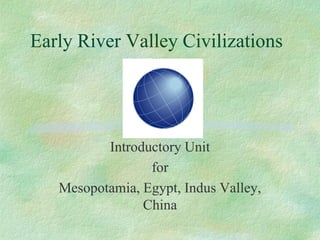
Notes: ancient river valley civilizations
- 1. Early River Valley Civilizations Introductory Unit for Mesopotamia, Egypt, Indus Valley, China
- 2. Five Characteristics of Civilization 1.Advanced Cities 2.Specialized Workers 3.Complex Institutions 4.Record Keeping 5.Advanced Technology
- 3. The Fertile Crescent The Fertile Crescent lies between the Tigris and Euphrates Rivers in a place called Mesopotamia, which in Greek means, “land between the rivers.” The 1stpeople to inhabit Mesopotamia were the Sumerians.
- 4. 1.Flooding of the rivers were unpredictable. 2.Sumer was a small region. When the floods came, all villages would be destroyed. 3.The natural resources of Sumer were extremely limited. Disadvantages of Mesopotamia
- 5. Advantages of Mesopotamia 1.To provide water, Sumerians built irrigation ditches to water their crops. 2.For defense, they built city walls with mud bricks. 3.Traded with people from the mountains for products they lacked.
- 6. Sumerian Cities By 3000 B.C., Sumerians had built numerous cities. They shared the same culture but began to different ways of governing their people with each having their own ruler. These cities became known as city-states. Military leaders were usually in charge. After their deaths, they would pass their power to their sons. Such a series of rulers from a single family is called a dynasty.
- 7. Sargon In 2350 B.C., Sargon invaded Sumer. Sargon was from the city-state Akkad which is north of Sumer. Sargon then created the world’s 1stempire. An empirebrings together several people, nations, or other states under the control of one ruler. Sargon’s empire lasted from 2350-2000 B.C.
- 8. The Babylonian Empire Began around 2000 B.C. The empire reached its peak during the reign of Hammurabi, from 1792-1750 B.C. Hammurabi became famous with the code of laws he put together
- 9. Hammurabi’s Code Hammurabi’s Code lists 282 specific laws dealing with everything from community, business conduct, and crime. The code applied to everyone, but different punishment was set for the rich and poor.
- 10. Ancient Egypt The Nile River Valley Civilization began around 3100 B.C. Egyptian kings came to be called pharaohs. Pharaohs controlled both the government and the army. This type of government is called a theocracy.
- 11. Egyptian Inventions Hieroglyphics: the Greek word hierosand gluphe, meaning “sacred carving” Architects were the 1stto use stone columns Also developed calendars, medicine, and treatments for wounds and fevers
- 12. End of the 1stEgyptian Civilization The Old Kingdom began to decline in 2180 B.C. Historians called the following turmoil the 1stIntermediate Period. During the Middle Kingdom, pharaohs regained control and restored law and order. Finally, around 1640 B.C., the Middle Kingdom was invaded by Asian chariot riders known as Hyksos which meant, “rulers of the uplands.” The Hyksos ruled Egypt from 1640-1570 B.C. This time is known as the 2ndIntermediate Period Egypt would once rise again later in history known as the New Kingdom.
- 13. Indus Valley Civilization The Indus Valley civilization began on the banks of the Indus and Ganges Rivers in India. Seasonal winds called monsoonsdominate India’s climate
- 14. Indus Valley Civilization Historians do not know much of the Indus Valley civilization because of their poor writing skills Historians believe people were farming villages along the Indus River around 3200 B.C.
- 15. Cities of the Indus Valley Civilization Some of the cities archaeologists have dug up are: Kalibangan Mohenjo-Daro Harappa
- 16. Achievements 1stto use the grid system Cities featured a fortified area called the citadel, which contained the major buildings of the city Religious artifacts show links to modern Hinduism. Traded with the Sumerians from 2350-2000 B.C.
- 17. Fall of the Indus Valley The Indus Valley began to decline around 1750 B.C. Three Reason Why: 1. The Indus River changed course which left crops unfertilized 2. People wore out the land 3. A major catastrophe or invasion by the Aryans
- 18. The 1stChinese Dynasty China’s first civilization developed on the Huang He River which means, “yellow river” 1stChinese Dynasty was the Xia Dynasty. Founded by Yu, an engineer and mathematician There are no written records of this dynasty; many believe this is a myth
- 19. Shang Dynasty 1strecorded Chinese Dynasty Shangs ruled from 1532-1027 B.C. Shang society was divided into 2 groups: Nobles Peasants
- 20. Shang Religion Religion played a major role in the Shang Dynasty They believed the spirits of their ancestors had the power to bring good fortune or disaster to living members of their family. Shang god was Shang Di
- 21. Zhou Dynasty Around 1027 B.C., the Zhou overthrew the Shang and established the Zhou dynasty Lasted from 1027-256 B.C. Zhou’s instituted the Mandate of Heaven, which said that the gods had given the throne to the Zhou’s because the Shang ruler had become a poor ruler; this was divine approval
- 22. Chinese Dynasties When disaster would strike, the Mandate of Heaven might be passed to another family Chinese history is marked by the succession of families until the early 1900’s. Historians describe the rise, decline, and the replacement of a dynasty as the dynastic cycle.
- 23. Zhou Government Zhou’s invented feudalism. Feudalism is a political system in which nobles, or lords are granted use of lands that legally belong the king
- 24. Fall of the Zhou Dynasty In 771 B.C., nomads from the north invaded and killed the Zhou king. Royal family members fled east and would rule another 500 years until 256 B.C. They would be brought down by another Chinese family.